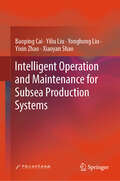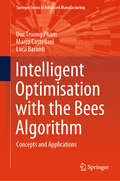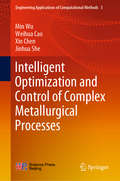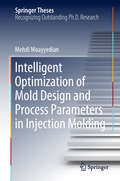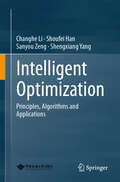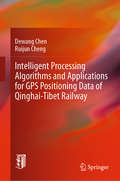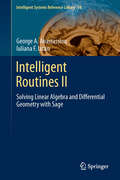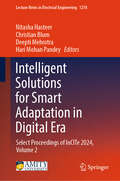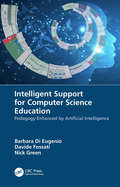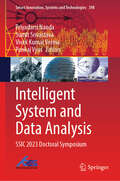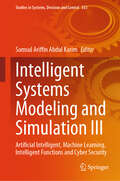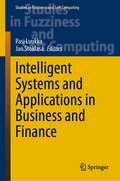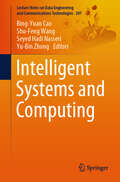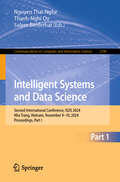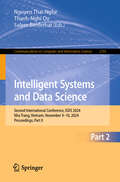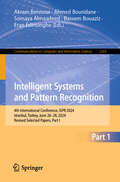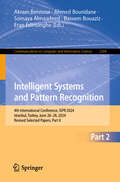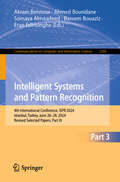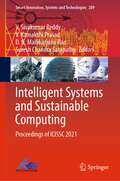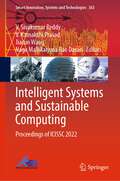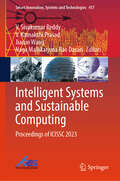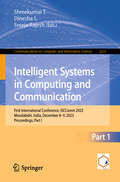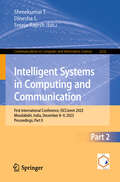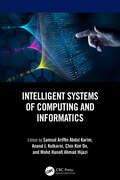- Table View
- List View
Intelligent Operation and Maintenance for Subsea Production Systems
by Baoping Cai Yonghong Liu Yiliu Liu Yixin Zhao Xiaoyan ShaoThis book systematically explores the challenges and advancements in integrating intelligent technologies with ocean engineering, with a particular focus on three core topics of fault diagnosis, fault prognosis, and maintenance for subsea production systems in harsh environments. It specifically addresses subsea engineering, focusing on the intersection with intelligent technologies in operation and maintenance, and also appeals to scholars and engineers from various disciplines, including Mechanical Engineering, Electrical Engineering, Oil and Gas Production, Reliability Engineering, and other related fields. This book introduces the latest algorithmic models for fault diagnosis, prognosis and maintenance, grounded in advanced methodologies such as big data, digital twin, Bayesian Networks. It features comprehensive figures, detailed tables, and a novel presentation style, making complex research more accessible. Additionally, this book stands out for its systematic approach to integrating cutting-edge methodologies with practical applications, providing practical insights and demonstrating foresight in the field of intelligent operation and maintenance for subsea production systems. The book is intended for graduate students, researchers, practitioners, industry engineers, and maintenance professionals specializing in subsea engineering, marine technology, intelligent systems, oil and gas production systems, and alike.
Intelligent Optimisation with the Bees Algorithm: Concepts and Applications (Springer Series in Advanced Manufacturing)
by Marco Castellani Duc Truong Pham Luca BarontiThis book offers an extensive guide to understanding, implementing, and applying the Bees Algorithm, a powerful nature-inspired optimisation metaheuristic that mimics the foraging behaviour of honey bees. In today's highly interconnected world, systems have become more difficult to optimise. This book addresses the challenge of solving complex optimisation problems efficiently and effectively by drawing inspiration from the remarkable problem-solving abilities observed in nature. The Bees Algorithm provides an elegant, simple, robust, and adaptable approach to navigate the complexities of high-dimensional, multimodal, or time-varying problems that often stymie traditional optimisation methods. This book offers an in-depth exploration of the algorithm, providing a thorough understanding of its underlying principles and mechanisms. It establishes a mathematical framework for the algorithm, facilitating a clearer insight into its behaviour and performance. Through empirical studies and benchmarks, the book demonstrates the algorithm's effectiveness across a range of optimisation problems. Additionally, it showcases practical applications of the Bees Algorithm in diverse fields such as engineering design, robotics, and manufacturing. Finally, it discusses the latest developments and variants of the algorithm, highlighting its potential for future research and innovation. With its accessible style and step-by-step guidance, this book equips readers—be they researchers, practitioners, or students in computer science, engineering, or optimisation—with the knowledge and tools to leverage the principles of swarm intelligence and biomimicry to solve the real-world optimisation challenges of the new industrial age.
Intelligent Optimization and Control of Complex Metallurgical Processes (Engineering Applications of Computational Methods #3)
by Xin Chen Min Wu Weihua Cao Jinhua SheThis book discusses the intelligent optimization and control of complex metallurgical processes, including intelligent optimization and control of raw-material proportioning processes, coking process, and reheating furnaces; intelligent control of thermal state parameters in sintering processes; and intelligent decoupling control of gas collection and mixing-and-pressurization processes. The intelligent control and optimization methods presented were originally applied to complex metallurgical processes by the authors, and their effectiveness and their advantages have been theoretically proven and demonstrated practically. This book offers an up-to-date overview of this active research area, and provides readers with state-of-the-art methods for the control of complex metallurgical processes.
Intelligent Optimization of Mold Design and Process Parameters in Injection Molding (Springer Theses)
by Mehdi MoayyedianThis book describes an effective framework for setting the right process parameters and new mold design to reduce the current plastic defects in injection molding. It presents a new approach for the optimization of injection molding process via (i) a new mold runner design which leads to 20 percent reduction in scrap rate, 2.5 percent reduction in manufacturing time, and easier ejection of injected part, (ii) a new mold gate design which leads to less plastic defects; and (iii) the introduction of a number of promising alternatives with high moldability indices. Besides presenting important developments of relevance academic research, the book also includes useful information for people working in the injection molding industry, especially in the green manufacturing field.
Intelligent Optimization: Principles, Algorithms and Applications
by Shengxiang Yang Sanyou Zeng Changhe Li Shoufei HanThis textbook comprehensively explores the foundational principles, algorithms, and applications of intelligent optimization, making it an ideal resource for both undergraduate and postgraduate artificial intelligence courses. It remains equally valuable for active researchers and individuals engaged in self-study. Serving as a significant reference, it delves into advanced topics within the evolutionary computation field, including multi-objective optimization, dynamic optimization, constrained optimization, robust optimization, expensive optimization, and other pivotal scientific studies related to optimization. Designed to be approachable and inclusive, this textbook equips readers with the essential mathematical background necessary for understanding intelligent optimization. It employs an accessible writing style, complemented by extensive pseudo-code and diagrams that vividly illustrate the mechanisms, principles, and algorithms of optimization. With a focus on practicality, this textbook provides diverse real-world application examples spanning engineering, games, logistics, and other domains, enabling readers to confidently apply intelligent techniques to actual optimization problems. Recognizing the importance of hands-on experience, the textbook introduces the Open-source Framework for Evolutionary Computation platform (OFEC) as a user-friendly tool. This platform serves as a comprehensive toolkit for implementing, evaluating, visualizing, and benchmarking various optimization algorithms. The book guides readers on maximizing the utility of OFEC for conducting experiments and analyses in the field of evolutionary computation, facilitating a deeper understanding of intelligent optimization through practical application.
Intelligent Processing Algorithms and Applications for GPS Positioning Data of Qinghai-Tibet Railway
by Dewang Chen Ruijun ChengTaking the Qinghai–Tibet Railway as an example, this book introduces intelligent processing for Global Positioning Data (GPS) data. Combining theory with practical applications, it provides essential insights into the Chinese Qinghai–Tibet Railway and novel methods of data processing for GPS satellite positioning, making it a valuable resource for all those working with train control systems, train positioning systems, satellite positioning, and intelligent data processing. As satellite positioning guarantees the safe and efficient operation of train control systems, it focuses on how to best process the GPS data collected, including methods for error detection, reduction and information fusion.
Intelligent Routines II
by George A. Anastassiou Iuliana F. Iatan"Intelligent Routines II: Solving Linear Algebra and Differential Geometry with Sage" contains numerous of examples and problems as well as many unsolved problems. This book extensively applies the successful software Sage, which can be found free online http://www. sagemath. org/. Sage is a recent and popular software for mathematical computation, available freely and simple to use. This book is useful to all applied scientists in mathematics, statistics and engineering, as well for late undergraduate and graduate students of above subjects. It is the first such book in solving symbolically with Sage problems in Linear Algebra and Differential Geometry. Plenty of SAGE applications are given at each step of the exposition.
Intelligent Solutions for Smart Adaptation in Digital Era: Select Proceedings of InCITe 2024, Volume 2 (Lecture Notes in Electrical Engineering #1278)
by Christian Blum Hari Mohan Pandey Nitasha Hasteer Deepti MehrotraThis book comprises the select peer-reviewed proceedings of the 4th International Conference on Information Technology (InCITe-2024). It aims to provide a comprehensive knowledge base highlighting state-of-the-art research and development and best practices for intelligent solutions in the digital era. It covers adaptive intelligence, decision intelligence, artificial intelligence, deep learning, machine learning, data science, and enabling technologies for IoT, blockchain, and other futuristic technologies. The content would serve as a rich knowledge repository on information & communication technologies, neural networks, fuzzy systems, natural language processing, data mining & warehousing, big data analytics, cloud computing, social networks and intelligence, decision-making, and modeling, information systems, IT architectures, and security related aspects. This book provides a valuable resource for those in academia and industry.
Intelligent Support for Computer Science Education: Pedagogy Enhanced by Artificial Intelligence
by Nick Green Barbara Di Eugenio Davide FossatiIntelligent Support for Computer Science Education presents the authors’ research journey into the effectiveness of human tutoring, with the goal of developing educational technology that can be used to improve introductory Computer Science education at the undergraduate level. Nowadays, Computer Science education is central to the concerns of society, as attested by the penetration of information technology in all aspects of our lives; consequently, in the last few years interest in Computer Science at all levels of schooling, especially at the college level, has been flourishing. However, introductory concepts in Computer Science such as data structures and recursion are difficult for novices to grasp. Key Features: Includes a comprehensive and succinct overview of the Computer Science education landscape at all levels of education. Provides in-depth analysis of one-on-one human tutoring dialogues in introductory Computer Science at college level. Describes a scalable, plug-in based Intelligent Tutoring System architecture, portable to different topics and pedagogical strategies. Presents systematic, controlled evaluation of different versions of the system in ecologically valid settings (18 actual classes and their laboratory sessions). Provides a time-series analysis of student behavior when interacting with the system. This book will be of special interest to the Computer Science education community, specifically instructors of introductory courses at the college level, and Advanced Placement (AP) courses at the high school level. Additionally, all the authors’ work is relevant to the Educational Technology community, especially to those working in Intelligent Tutoring Systems, their interfaces, and Educational Data Mining, in particular as applied to human-human pedagogical interactions and to user interaction with educational software.
Intelligent System and Data Analysis: SSIC 2023 Doctoral Symposium (Smart Innovation, Systems and Technologies #398)
by Sumit Srivastava Vivek Kumar Verma Priyadarsi Nanda Pankaj VyasThis book features original papers from the Doctoral Symposium in 4th International Conference on Smart IoT Systems: Innovations and Computing (SSIC 2023), organized by Manipal University, Jaipur, India, during 26–27 October 2023. It discusses scientific works related to data engineering in the context of computational collective intelligence consisted of interaction between smart devices for smart environments and interactions. The book offers high-quality content and the broad range of topics useful for researchers pursuing advanced studies.
Intelligent Systems Modeling and Simulation III: Artificial Intelligent, Machine Learning, Intelligent Functions and Cyber Security (Studies in Systems, Decision and Control #553)
by Samsul Ariffin Abdul KarimThis book continues the previous edition: Samsul Ariffin Abdul Karim (2022). Intelligent Systems Modeling and Simulation II: Machine Learning, Neural Networks, Efficient Numerical Algorithm and Statistical Methods, Studies in Systems, Decision and Control (SSDC, volume 444, 22k Access). After two years, Intelligent Systems Modeling and Simulation have evolved tremendously through the latest and advanced emergence technologies and many highly sophisticated algorithms have been developed by blending artificial intelligence (AI) and mathematics, statistics, data modelling and other related research areas. These blends offer many opportunities and further investigations into the overlapand equality between these areas. It is a well-known fact that most industries and companies have utilized this IR4.0 architecture in various levels of manufacturing and decision processes. Besides, nowadays IR5.0 or Society5.0 has also been embedded into various systems in industries as well as in Teaching and Learning (TL). The combination of IR4.0 and Society 5.0 may result in more impactful outcomes, especially in automated decision-making and reliable simulations-based modelling. Furthermore, IR4.0 and Society5.0 through Data-Driven have made a significant contribution to the government and companies to analyse big data via predictive analytics. Cyber security firewalls on all systems must be up to date to prevent any malicious attacks by hackers. Otherwise, our citizens might be scammed and according to NBC News, the total loss for 2022 is around USD 8.8 billion. These are very huge amount. Just recently, COVID-19 has been spreading all over the world again. To assist the Ministry of Health (MOH) and other government agencies, it is very crucial to identify, predict, detect and quarantine the COVID-19 on the susceptible persons soonest possible. Intelligent Image Processing techniques are very demanding here. This is to ensure that we can control and minimise the spread. Inspire by these latest developments, in this book, various experts in the areas of Artificial Intelligence, Machine Learning, Deep Learning, Neural Networks, Modeling and Simulation, Cyber Security and Awareness, Intelligent Statistical Methods, Big Data Analytics, Sentiment Analytics, Intelligent Function Approximation, Image Processing in medical imaging especially on COVID-19, AI in Teaching and Learning, and Computational Intelligence will share their latest studies and experiences. Their finding is in line with United Nations Sustainable Development Goals (SDGs) such as No. 9: Industry, Innovation, and Infrastructure, particularly Target 9.4, 9.5, 9.a, 9.b and 9.c, No. 11: Sustainable Cities and Communities particularly Target 11.b and Indicators 11.b.1 and 11.b.2, and SDG No. 4: Quality Education; particularly Target 4.7 and Indicator 4.7.1. This book is highly suitable for postgraduate students and researchers to get the state-of-the-art current research directions as well as for the scientists that have an interest and working in intelligent numerical modelling and simulations through AI, Machine Learning, Neural Networks, and its related counterparts.
Intelligent Systems and Applications in Business and Finance (Studies in Fuzziness and Soft Computing #415)
by Pasi Luukka Jan StoklasaThis book presents a selection of current research results in the field of intelligent systems and draws attention to their practical applications and issues connected with the areas of decision-making, economics, business and finance. The nature of the contributions is interdisciplinary – combining psychological and behavioural aspects with the theory and practice of decision-support, design of intelligent systems and development of machine learning tools. The authors, among other topics, discuss the multi-expert evaluation with intangible criteria, suggest a redefinition of the standard multiple-criteria decision-making framework, propose novel methods for causal map analysis and new feature selection methods. The topics are selected to stress the potential of the up-to-date intelligent methods to deal with practical problems relevant in these areas and to provide inspiration for advanced students, researchers and practitioners in the respective fields.
Intelligent Systems and Computing (Lecture Notes on Data Engineering and Communications Technologies #207)
by Bing-Yuan Cao Yu-Bin Zhong Seyed Hadi Nasseri Shu-Feng WangThis book includes high quality research papers submitted at the 2022 “Four Session (ICFIE, ICORG, GDORS, CGHMORS) Celebration” Joint International Conference held on December 28, 2022 and the online meeting of the Fuzzy Information and Engineering Branch of the China Operations Research Society on September 17, 2022. It covers topics in the fields of certainty, stochastic uncertainty, and fuzzy uncertainty, including computer science and mathematics, operations research and control, artificial intelligence, information and engineering technology, barrier-free communication for people with disabilities, digital logistics and knowledge representation, medical applications, queuing theory and game theory, algorithms and optimization methods. The book is a valuable reference book for scholars, engineers, management professionals, and graduate, undergraduate, and vocational students interested in computer science, mathematics, and fuzzy mathematics and operations research, as well as their applications in information technology and engineering.
Intelligent Systems and Data Science: Second International Conference, ISDS 2024, Nha Trang, Vietnam, November 9–10, 2024, Proceedings, Part I (Communications in Computer and Information Science #2190)
by Salem Benferhat Nguyen Thai-Nghe Thanh-Nghi DoThis two-volume set constitutes the refereed proceedings of the Second International Conference, ISDS 2024, held in Nha Trang, Vietnam, during November 9–10, 2024. The 38 full papers and 10 short papers were carefully reviewed and selected from 129 submissions. They were categorized under the topical sections as follows: AI in E-Commerce, Agriculture, and Aquaculture; AI in Health Care Analytics; Big Data, IoT, and Cloud Computing; and Natural Language Processing.
Intelligent Systems and Data Science: Second International Conference, ISDS 2024, Nha Trang, Vietnam, November 9–10, 2024, Proceedings, Part II (Communications in Computer and Information Science #2191)
by Salem Benferhat Nguyen Thai-Nghe Thanh-Nghi DoThis two-volume set constitutes the refereed proceedings of the Second International Conference, ISDS 2024, held in Nha Trang, Vietnam, during November 9–10, 2024. The 38 full papers and 10 short papers were carefully reviewed and selected from 129 submissions. They were categorized under the topical sections as follows: AI in E-Commerce, Agriculture, and Aquaculture; AI in Health Care Analytics; Big Data, IoT, and Cloud Computing; and Natural Language Processing.
Intelligent Systems and Data Science: Third International Conference, ISDS 2025, Can Tho City, Vietnam, October 18–19, 2025, Proceedings, Part I (Communications in Computer and Information Science #2713)
by Salem Benferhat Nguyen Thai-Nghe Thanh-Nghi DoThis two-volume set constitutes the refereed proceedings of the Third International Conference, ISDS 2025, held in Can Tho City, Vietnam, during October 18–19, 2025. The 67 full papers and 2 Short papers included in this book were carefully reviewed and selected from 181 submissions. They focus on the development of innovative, interpretable, and explainable data science and artificial intelligence technologies. They were organized in topical sections as follows: Part I: Intelligent Systems and Data Science (CCIS 2714).Part II: Intelligent Systems and Data Science (CCIS 2716).
Intelligent Systems and Pattern Recognition: 4th International Conference, ISPR 2024, Istanbul, Turkey, June 26-28, 2024, Revised Selected Papers, Part I (Communications in Computer and Information Science #2303)
by Ahmed Bouridane Akram Bennour Somaya Almaadeed Bassem Bouaziz Eran EdirisingheThis Three-volume set CCIS 2303-2305 constitutes the proceedings of the 4th International Conference on Intelligent Systems and Pattern Recognition, ISPR 2024, held in Istanbul, Turkey, in June 26–28, 2024. The 77 full papers presented were thoroughly reviewed and selected from the 210 submissions. The conference provided an interdisciplinary forum for the exchange of innovative advancements in the fields of artificial intelligence and pattern recognition.
Intelligent Systems and Pattern Recognition: 4th International Conference, ISPR 2024, Istanbul, Turkey, June 26-28, 2024, Revised Selected Papers, Part II (Communications in Computer and Information Science #2304)
by Ahmed Bouridane Akram Bennour Somaya Almaadeed Bassem Bouaziz Eran EdirisingheThis Three-volume set CCIS 2303-2305 constitutes the proceedings of the 4th International Conference on Intelligent Systems and Pattern Recognition, ISPR 2024, held in Istanbul, Turkey, in June 26–28, 2024. The 77 full papers presented were thoroughly reviewed and selected from the 210 submissions. The conference provided an interdisciplinary forum for the exchange of innovative advancements in the fields of artificial intelligence and pattern recognition.
Intelligent Systems and Pattern Recognition: 4th International Conference, ISPR 2024, Istanbul, Turkey, June 26-28, 2024, Revised Selected Papers, Part III (Communications in Computer and Information Science #2305)
by Ahmed Bouridane Akram Bennour Somaya Almaadeed Bassem Bouaziz Eran EdirisingheThis Three-volume set CCIS 2303-2305 constitutes the proceedings of the 4th International Conference on Intelligent Systems and Pattern Recognition, ISPR 2024, held in Istanbul, Turkey, in June 26–28, 2024. The 77 full papers presented were thoroughly reviewed and selected from the 210 submissions. The conference provided an interdisciplinary forum for the exchange of innovative advancements in the fields of artificial intelligence and pattern recognition.
Intelligent Systems and Sustainable Computing: Proceedings of ICISSC 2021 (Smart Innovation, Systems and Technologies #289)
by Suresh Chandra Satapathy V. Kamakshi Prasad V. Sivakumar Reddy D. N. Mallikarjuna RaoThe book is a collection of best selected research papers presented at the International Conference on Intelligent Systems and Sustainable Computing (ICISSC 2021), held in School of Engineering, Malla Reddy University, Hyderabad, India, during 24–25 September 2021. The book covers recent research in intelligent systems, intelligent business systems, soft computing, swarm intelligence, artificial intelligence and neural networks, data mining & data warehousing, cloud computing, distributed computing, big data analytics, Internet of Things (IoT), machine learning, speech processing, sustainable high-performance systems, VLSI and embedded systems, image and video processing, and signal processing and communication.
Intelligent Systems and Sustainable Computing: Proceedings of ICISSC 2022 (Smart Innovation, Systems and Technologies #363)
by V. Kamakshi Prasad Jiacun Wang V. Sivakumar Reddy Naga Mallikarjuna Rao DasariThis book is a collection of best selected research papers presented at Second International Conference on Intelligent Systems and Sustainable Computing (ICISSC 2022), held in School of Engineering, Malla Reddy University, Hyderabad, India, during December 16–17, 2022. The book covers recent research in intelligent systems, intelligent business systems, soft computing, swarm intelligence, artificial intelligence and neural networks, data mining and data warehousing, cloud computing, distributed computing, big data analytics, Internet of things (IoT), machine learning, speech processing, sustainable high-performance systems, VLSI and embedded systems, image and video processing and signal processing and communication.
Intelligent Systems and Sustainable Computing: Proceedings of ICISSC 2023 (Smart Innovation, Systems and Technologies #417)
by V. Kamakshi Prasad Jiacun Wang V. Sivakumar Reddy Naga Mallikarjuna Rao DasariThis book is a collection of best-selected research papers presented at Third International Conference on Intelligent Systems and Sustainable Computing (ICISSC 2023), held in School of Engineering, Malla Reddy University, Hyderabad, India, during December 22–23, 2023. The book covers recent research in intelligent systems, intelligent business systems, soft computing, swarm intelligence, artificial intelligence and neural networks, data mining and data warehousing, cloud computing, distributed computing, big data analytics, Internet of Things (IoT), machine learning, speech processing, sustainable high-performance systems, VLSI and embedded systems, image and video processing, and signal processing and communication. Chapters 7 and 32 in this book is available open access under a CC BY 4.0 license at link.springer.com.
Intelligent Systems in Computing and Communication: First International Conference, ISCComm 2023, Moodabidri, India, December 8–9, 2023, Proceedings, Part I (Communications in Computer and Information Science #2231)
by Shreekumar T. Dinesha L. Sreeja RajeshThis book constitutes the refereed proceedings of the First International Conference, Intelligent Systems in Computing and Communication, ISCComm 2023, held in Moodabidri, India, during December 8–9, 2023. The 36 full papers and 17 short papers were carefully reviewed and selected from 245 proceedings. They were categorized under the topical sections as follows: Part I: Artificial Intelligence and Machine Learning Part II: IoT&Blockchain Technology, Communication Technology and Data Processing, Image/Video Analysis and Processing
Intelligent Systems in Computing and Communication: First International Conference, ISCComm 2023, Moodabidri, India, December 8–9, 2023, Proceedings, Part-II (Communications in Computer and Information Science #2232)
by Shreekumar T. Dinesha L. Sreeja RajeshThis book constitutes the refereed proceedings of the First International Conference, Intelligent Systems in Computing and Communication, ISCComm 2023, held in Moodabidri, India, during December 8–9, 2023. The 36 full papers and 17 short papers were carefully reviewed and selected from 245 proceedings. They were categorized under the topical sections as follows: Part I: Artificial Intelligence and Machine Learning Part II: IoT&Blockchain Technology, Communication Technology and Data Processing, Image/Video Analysis and Processing
Intelligent Systems of Computing and Informatics
by Anand J. Kulkarni Chin Kim On Abdul Karim, Samsul Ariffin Hijazi, Mohd Hanafi AhmadSince 2011, the Fourth Industrial Revolution (IR4.0) has played a significant role in education, research, and industry. Data technologies have also evolved rapidly to cater to the rapidly growing size of the data as well as to enhance the security of the shared data through multiple resources and platforms.Intelligent Systems of Computing and Informatics aims to develop a new Intelligent Systems of Computing and Informatics (ISCI) to cater to the needs of industries in line with the United Nations’ Sustainable Development Goals (SDGs) of affordable and clean energy and sustainable cities and communities.Comprising 20 chapters by experts from all over the world, this book covers such topics as data technologies, machine learning, signal and image processing, software systems efficiency, computer networking, Internet of Things, and computational intelligence for real-life problems.Key Features: Develops a new system for computing and informatics Provides the state of the art of current research and studies in intelligence systems Written by experts in the field of computing and informatics This book is aimed at postgraduate students, researchers working in various research and development (R&D) agencies, and practitioners, as well as scientists that have an interest in ISCI.
